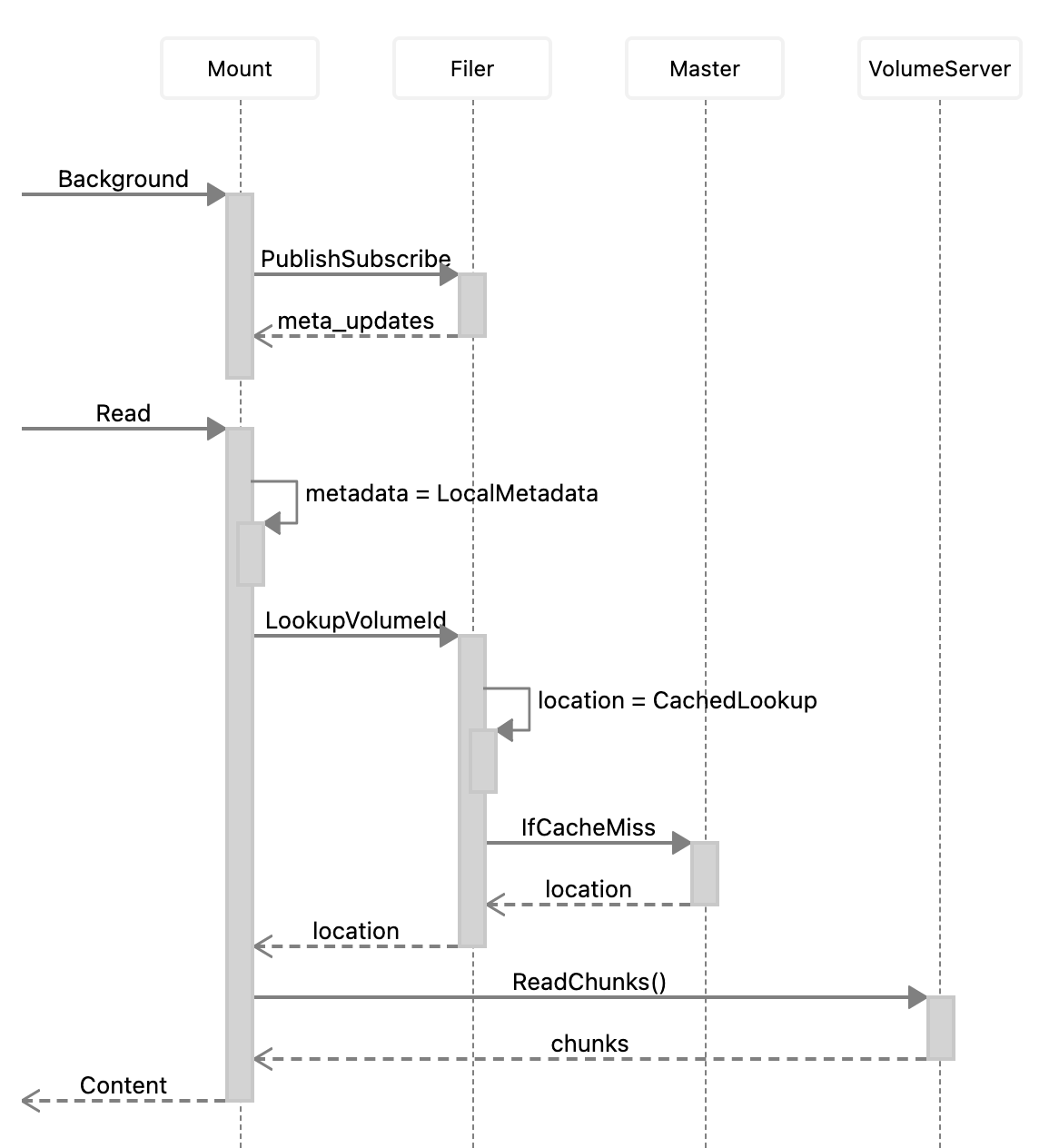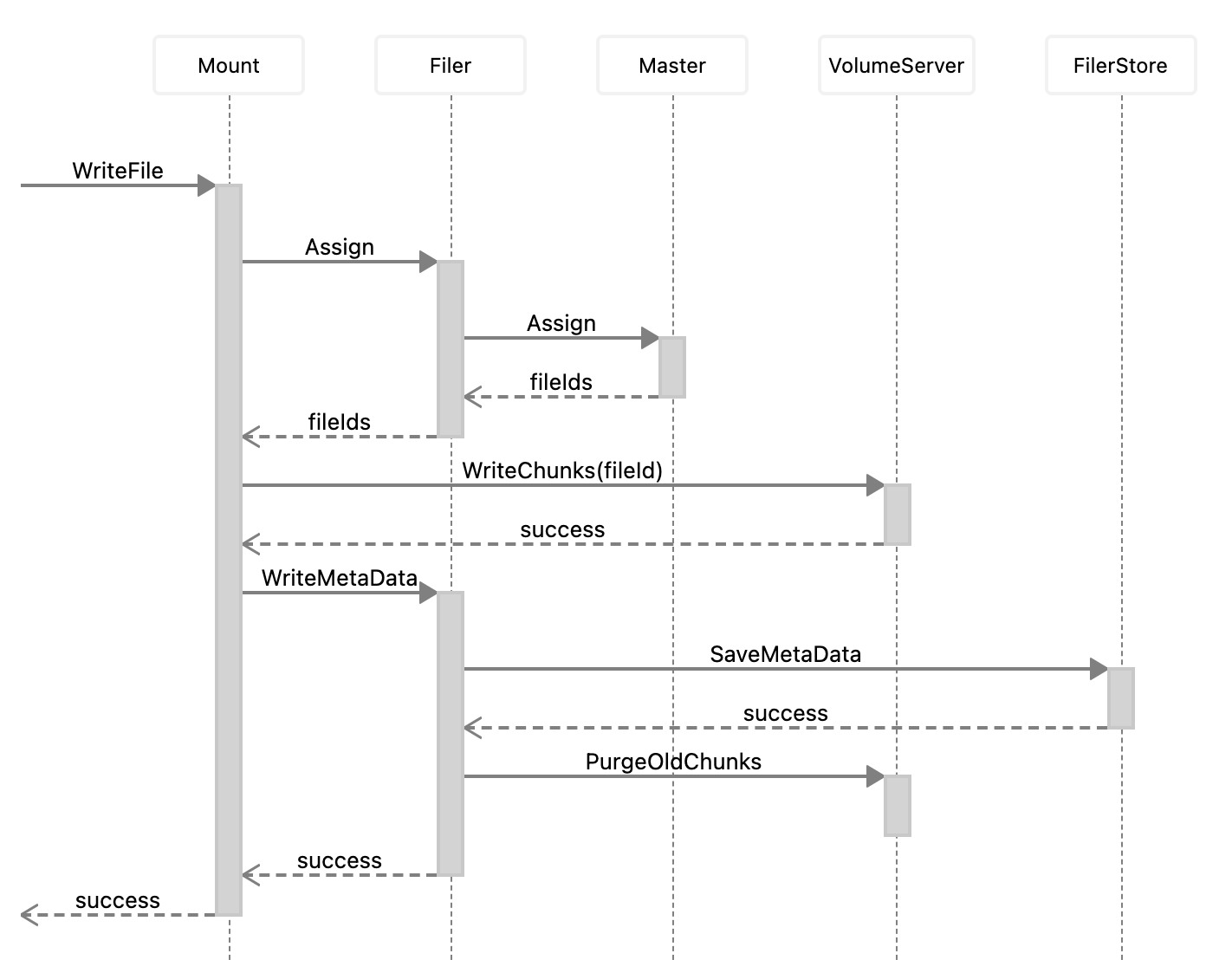Supported Features
With "weed mount", the files can be operated as a local file. The following operations are supported.
- file read / write
- create new file
- mkdir
- list
- remove
- rename
- chmod
- chown
- soft link
- hard link
- display free disk space
- copy file range
- lseek
Mount as FUSE
This uses seaweedfs/fuse, which enables writing FUSE file systems on Linux and OS X. On OS X, it requires OSXFUSE (https://osxfuse.github.io/).
# assuming you already started weed master, weed volume and filer
weed mount -filer=localhost:8888 -dir=/some/existing/dir -filer.path=/one/remote/folder
weed mount -filer=localhost:8888 -dir=/some/existing/dir -filer.path=/
# example: mount one collection and a folder to a local directory
weed mount -filer=localhost:8888 -dir=~/folder_on_seaweedfs -filer.path=/home/chris -collection=chris
It is also possible use mount and fuse subtype:
cp weed /sbin/weed
mount -t fuse.weed fuse /mnt -o "filer=localhost:8888,filer.path=/"
Or add weed as a mount subtype:
cp weed /sbin/mount.weed
mount -t weed fuse /mnt -o "filer=localhost:8888,filer.path=/"
To mount with multiple filers enclose filer parameter with quotes and separate servers with comma:
cp weed /sbin/mount.weed
mount -t weed fuse /mnt -o "filer='192.168.0.1:8888,192.168.0.2:8888',filer.path=/"
Now you can operate the SeaweedFS files, browsing or modifying directories and files, in local file system. To unmount, just shut it down the "weed mount".
Mount outside of a SeaweedFS cluster
In addition to connecting to filer server, weed mount also directly connects to volume servers directly for better performance.
However, if the SeaweedFS cluster is started by Kubernetes or docker-compose and
the volume servers only knows its own IP addresses inside the cluster,
weed mount is not able to access the volume servers from outside of the cluster.
weed mount -volumeServerAccess=[direct|publicUrl|filerProxy] option can help here. You can choose to proxy the requests to volume servers via filer.
So only filer needs to be exposed. Or you can choose to expose the public URLs of volume servers.
Multiple mounts with multiple Filers of a SeaweedFS cluster
Updates from one filer are transferred to the other filers. The filers would not be constantly querying the filer stores for updates. Instead, the filers will listen to each other for updates, which is more efficient.
So for the following topology, the updates from one mount can be propagated to other mounts.
mount1 ---> filer1 ---> filer2 ---> mount2
|
+-----> filer3 ---> mount3
However, in most cases, one filer should be enough, since the mount will only get asynchronous metadata updates to filer, and will read and write to the volume servers directly, one filer should be enough to handle most of the work.
filer ---- mount1
|
+------ mount2
|
+------ mount3
Mount directory on host from docker-compose
If docker compose is being used to manage the server (eg. https://github.com/seaweedfs/seaweedfs/wiki/Getting-Started#with-compose) it's possible to mount a directory on the host with docker privileged mode like so:
mount_1:
image: chrislusf/seaweedfs
cap_add:
- SYS_ADMIN
devices:
- "/dev/fuse:/dev/fuse"
volumes:
- "/hostdata/mount:/mnt:z,shared"
entrypoint: weed
command: mount
environment:
- DIR=/mnt/data
- DIRAUTOCREATE=true
- FILER=localhost:8888,localhost:8889
depends_on:
- master
- filer
Weed Mount Architecture
weed mount has a persistent client connecting to Master, to get the location updates of all volumes.
There are no network round trip to lookup the volume id location.
weed mount also continuously synchronize all metadata updates with the Filer. So later reads would not need a network read from Filer, and the metadata reads, e.g., directory listings, are all local operations.
For reads:
- Mount optionally lookups volume Id => Weed Filer => Weed Master
- Mount Reads File Chunks => Weed Volume Servers
For writes:
- Mount uploads data to Weed Volume Servers, and breaks the large files into chunks.
- Mount writes the metadata and chunk information into Filer and then into Filer database.
Weed Mount Performance
Compared to any other distributed file systems, the weed mount performance should exceed most other solutions, or at least on par. This is because weed mount has multiple optimization techniques:
- asynchronously replicate the metadata updates to local db. There are no remote metadata read operations at all.
- cached most recently accessed data.
- batch small writes into large writes.
Due to the limitation of FUSE and network IO, the performance of the mounted file system is expected to be less than local disk. weed mount still needs to write to remote filer server and volume servers to ensure data persistence.
So if your data is temporary local files, try to move the writes to other unmounted directories. If the data is shared across the distributed file system, the additional cost to write should be acceptable for most cases.
For example, you can create a soft link to a directory or a file on a local disk, and put temp data there.
Sysbench Benchmark Results
"sysbench" is used here. The mount command line is weed mount -dir=xx
If you have better benchmarking tools, please share your results.
$ brew install sysbench
$ cd /a/mounted/folder
$ sysbench --test=fileio --file-total-size=1G prepare
$ sysbench --test=fileio --file-total-size=1G --file-test-mode=rndrw --max-time=60 --max-requests=0 --num-threads=1 --file-block-size=1m run
WARNING: the --test option is deprecated. You can pass a script name or path on the command line without any options.
WARNING: --max-time is deprecated, use --time instead
sysbench 1.0.20 (using system LuaJIT 2.1.0-beta3)
Running the test with following options:
Number of threads: 1
Initializing random number generator from current time
Extra file open flags: (none)
128 files, 8MiB each
1GiB total file size
Block size 1MiB
Number of IO requests: 0
Read/Write ratio for combined random IO test: 1.50
Periodic FSYNC enabled, calling fsync() each 100 requests.
Calling fsync() at the end of test, Enabled.
Using synchronous I/O mode
Doing random r/w test
Initializing worker threads...
Threads started!
File operations:
reads/s: 958.24
writes/s: 638.84
fsyncs/s: 2045.67
Throughput:
read, MiB/s: 958.24
written, MiB/s: 638.84
General statistics:
total time: 60.0045s
total number of events: 218458
Latency (ms):
min: 0.02
avg: 0.27
max: 166.61
95th percentile: 1.01
sum: 59775.56
Threads fairness:
events (avg/stddev): 218458.0000/0.00
execution time (avg/stddev): 59.7756/0.00
The above is single-threaded. The following uses 16 threads.
$ sysbench --test=fileio --file-total-size=1G --file-test-mode=rndrw --max-time=60 --max-requests=0 --num-threads=16 --file-block-size=1m run
WARNING: the --test option is deprecated. You can pass a script name or path on the command line without any options.
WARNING: --num-threads is deprecated, use --threads instead
WARNING: --max-time is deprecated, use --time instead
sysbench 1.0.20 (using system LuaJIT 2.1.0-beta3)
Running the test with following options:
Number of threads: 16
Initializing random number generator from current time
Extra file open flags: (none)
128 files, 8MiB each
1GiB total file size
Block size 1MiB
Number of IO requests: 0
Read/Write ratio for combined random IO test: 1.50
Periodic FSYNC enabled, calling fsync() each 100 requests.
Calling fsync() at the end of test, Enabled.
Using synchronous I/O mode
Doing random r/w test
Initializing worker threads...
Threads started!
File operations:
reads/s: 2152.89
writes/s: 1435.49
fsyncs/s: 4625.57
Throughput:
read, MiB/s: 2152.89
written, MiB/s: 1435.49
General statistics:
total time: 60.0198s
total number of events: 490963
Latency (ms):
min: 0.03
avg: 1.95
max: 215.50
95th percentile: 9.22
sum: 958761.77
Threads fairness:
events (avg/stddev): 30685.1875/161.07
execution time (avg/stddev): 59.9226/0.00
Sysbench Result Analysis
sysbench works on 128 files, 8MiB each. It will do random read and write on these files.
weed mount has default cacheCapacityMB=1000, but because the cache has different section for different sized chunks, the actual cache used for this workload is about 500MB. However, due to the randomness, the actual hit rate is not high.
Even with the cache, the data are persisted on the filer and volume servers first, then cached locally.
Common Problems
Unmount
Sometimes weed mount can not start if the last mount process was not cleaned up.
You can clean up with these commands. Try any of them until it works:
// on mac
sudo umount /the/mounted/dir
diskutil unmount force /the/mounted/dir
sudo umount -f /the/mounted/dir
sudo umount -l /the/mounted/dir
// on linux
sudo umount -f /the/mounted/dir
sudo umount -l /the/mounted/dir
Still fail to mount on MacOS
From https://github.com/osxfuse/osxfuse/issues/358
FUSE needs to register a virtual device for exchanging messages between the kernel and the actual file system implementation running in user space. The number of available device slots is limited by macOS. So if you are using other software like VMware, VirtualBox, TunTap, Intel HAXM, ..., that eat up all free device slots, FUSE will not be able to register its virtual device.
Samba share mounted folder
From https://github.com/seaweedfs/seaweedfs/issues/936
The issue is with samba.conf. If you see NT_STATUS_ACCESS_DENIED error, try to add force user and force group to your samba.conf file.
[profiles]
comment = Users profiles
path = /home/chris/mm
guest ok = yes
browseable = yes
create mask = 0775
directory mask = 0775
force user = root
force group = root
What does "df" output means?
Size: total number of volumes * volume size limit
Used: (Logical Total Size of files - Logical Deleted File Size) * replication = physical disk size taken
Available = Size - Used
Introduction
API
Configuration
- Replication
- Store file with a Time To Live
- Failover Master Server
- Erasure coding for warm storage
- Server Startup Setup
- Environment Variables
Filer
- Filer Setup
- Directories and Files
- Data Structure for Large Files
- Filer Data Encryption
- Filer Commands and Operations
- Filer JWT Use
Filer Stores
- Filer Cassandra Setup
- Filer Redis Setup
- Super Large Directories
- Path-Specific Filer Store
- Choosing a Filer Store
- Customize Filer Store
Advanced Filer Configurations
- Migrate to Filer Store
- Add New Filer Store
- Filer Store Replication
- Filer Active Active cross cluster continuous synchronization
- Filer as a Key-Large-Value Store
- Path Specific Configuration
- Filer Change Data Capture
FUSE Mount
WebDAV
Cloud Drive
- Cloud Drive Benefits
- Cloud Drive Architecture
- Configure Remote Storage
- Mount Remote Storage
- Cache Remote Storage
- Cloud Drive Quick Setup
- Gateway to Remote Object Storage
AWS S3 API
- Amazon S3 API
- AWS CLI with SeaweedFS
- s3cmd with SeaweedFS
- rclone with SeaweedFS
- restic with SeaweedFS
- nodejs with Seaweed S3
- S3 API Benchmark
- S3 API FAQ
- S3 Bucket Quota
- S3 API Audit log
- S3 Nginx Proxy
AWS IAM
Machine Learning
HDFS
- Hadoop Compatible File System
- run Spark on SeaweedFS
- run HBase on SeaweedFS
- run Presto on SeaweedFS
- Hadoop Benchmark
- HDFS via S3 connector
Replication and Backup
- Async Replication to another Filer [Deprecated]
- Async Backup
- Async Filer Metadata Backup
- Async Replication to Cloud [Deprecated]
- Kubernetes Backups and Recovery with K8up
Messaging
Use Cases
Operations
Advanced
- Large File Handling
- Optimization
- Volume Management
- Tiered Storage
- Cloud Tier
- Cloud Monitoring
- Load Command Line Options from a file
- SRV Service Discovery

